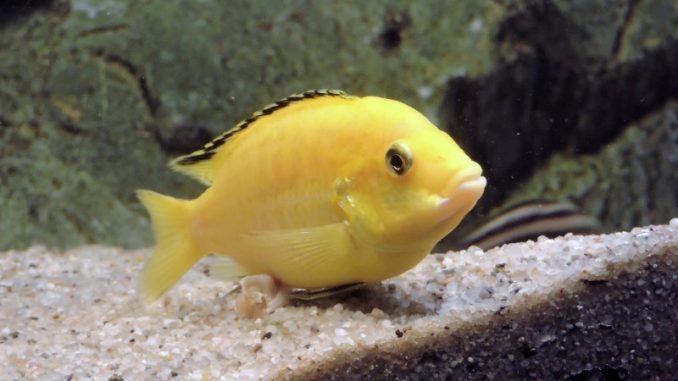
The yellow lab cichlid is a freshwater fish that’s part of the Cichlidae family. This unique species is related to over 30 types of cichlids.
Yellow lab cichlids are native to East Africa, specifically the western coastal region of Lake Malawi. These cichlids are also called electric yellow cichlids or lemon yellow lab cichlids because of their bright yellow coloration and blue streak.
The yellow lab cichlid species is semi-aggressive, but in the right tank conditions, it can be a peaceful tank mate. This fish is popular amongst aquarists because of its ease of care and interesting appearance.
TABLE OF CONTENTS
Yellow Lab Cichlid Facts & Overview
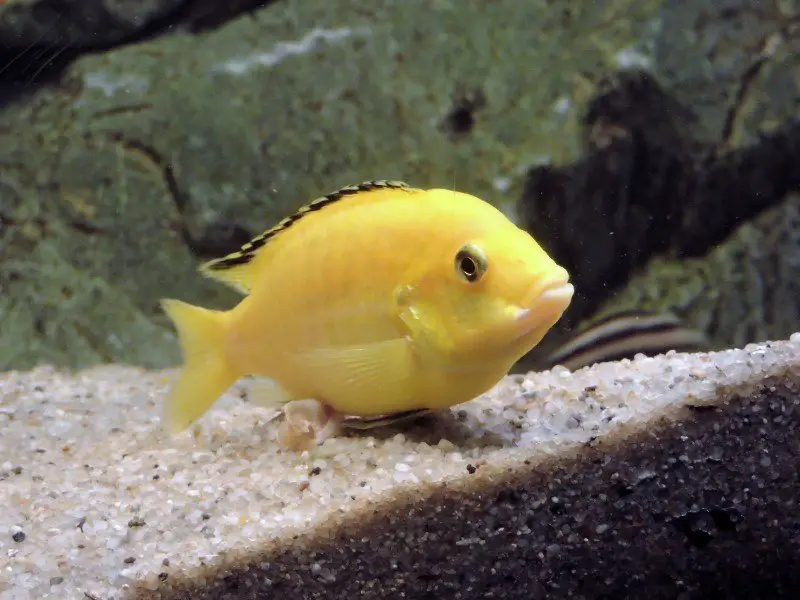
| Category | Rating |
| Care Level | Easy |
| Temperament | Semi-aggressive |
| Color | Bright yellow with a blue streak hap |
| Lifespan | Up to 10 years |
| Size | Up to four inches long |
| Diet | Carnivore in the wild |
| Family | Cichlidae |
| Minimum Tank Size | 30 gallons |
| Tank Setup | Freshwater, plants, caves |
| Compatibility | Compatible with non-aggressive species |
The yellow lab cichlid is known scientifically as the labidochromis caeruleus.
Wild yellow lab cichlids share their tropical habitat with more than 500 other species of cichlids. Aquarists caring for yellow lab cichlids should ensure the tank conditions are similar to the cichlid’s natural habitat.
Yellow lab cichlids are sold for approximately $6.99 and are easy to purchase from most pet stores and online shops.
Appearance & Behavior
The yellow lab cichlid has an elongated, stocky body. The fish has a blue/black stripe along its anal and dorsal fin, which darkens as the fish matures. A stressed yellow lab cichlid will look dull or will develop black patches over its body.
Dominant male yellow lab cichlids have a bright yellow coloration, and their scales look almost gold. Females and males display a black stripe on their dorsal fins, but the males also have black anal and ventral fins. Look for light spots on the males’ fins, which aren’t present in females. Male yellow lab cichlids are bigger than females.
Typical Behavior
The yellow lab cichlid is a peaceful fish with territorial tendencies. This fish can become aggressive when the aquarium is overcrowded, or when it shares a tank with another dominant species.
Male yellow lab cichlids are particularly aggressive and will fight other males in the aquarium. You should keep the number of yellow lab cichlid males in the tank to a minimum to ensure the aquarium environment stays calm.
Yellow lab cichlids will flirt with one another by shaking their fins and tails. These fish also chase and nip one another before mating. This nipping is known as kissing in the fishkeeping world.
Yellow lab cichlids typically swim in every area of the tank. They feed at the top of the tank, but will also eat any leftover food that sinks to the bottom. Yellow cichlids are active fish with strong swimming abilities.
Ensure the aquarium maintains a natural day to night light cycle. Yellow lab cichlids are active during the day and rest or sleep at night. Because of this, aquarists should feed their cichlids during the day to make sure the fish maintain a healthy daily rhythm.
Yellow Lab Cichlid Care
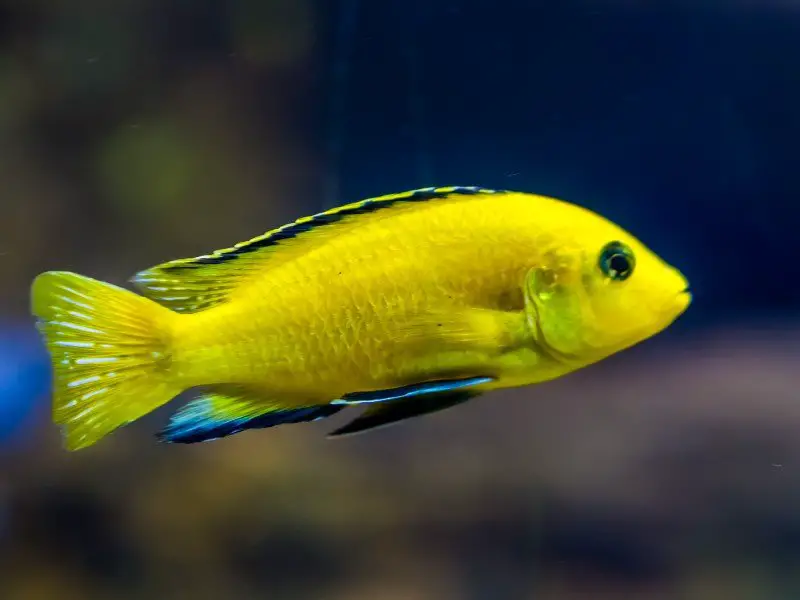
Yellow lab cichlids are easy to care for. These fish are suitable for amateurs and experienced aquarists.
Cichlids are native to tropical freshwaters of Africa and South America and are accustomed to slow-flowing water rich with vegetation and other species of fish in the wild. To mimic this environment, you should stick to a freshwater aquarium setup containing live plants and decorations.
Yellow lab cichlids are very easy to feed. These fish will happily eat spirulina flakes and fish food flakes. However, yellow labs are prone to overeating, and captive fish often contract Malawi bloat. Malawi bloat can occur from eating too much protein, so you should keep live food and high-protein fish flakes to a minimum.
Habitat and Tank Requirements
Yellow lab cichlids need plenty of live plants and hiding places to thrive. These fish live in highly vegetated water and require decorations and dim lighting to resemble their natural habitat.
Lake Malawi is the southernmost lake in east Africa. This lake is an African Great Lake and has an average depth of over 900 feet. The lake has three distinct water layers and is bursting with wildlife and vegetation. Over 600 species of cichlids are thought to inhabit the waters of Lake Malawi.
To suit the yellow lab cichlid’s environment, you should fashion your home aquarium to resemble lake Malawi’s natural habitat. Water parameters, plants, and decorations need to be specially selected for yellow lab cichlids to feel comfortable in the tank.
Tank Conditions
Yellow lab cichlids thrive in large freshwater tanks. Here are some of the tank requirements for the species:
Water type: Yellow lab cichlids require a freshwater tank setup.
Tank size: You need a 30-gallon tank or larger for yellow lab cichlids. Long tanks are better than deep tanks as they allow females to hide and swim away from over-attentive males.
Ideal water temperatures: Keep the water temperature between 74ºF and 84ºF. Watch out for fluctuating water temperatures as this will cause the fish distress.
Substrate: You can add a sand or gravel substrate to a yellow lab cichlid tank. Yellow lab cichlids will also do well in a tank with a mixture of sand and gravel substrate.
Decorations: Decorate the tank with hiding spaces and areas for the fish to explore. Bits of driftwood and rocks are ideal tank decorations.
pH level: Make sure the water pH level stays between 7.2 and 8.8.
Filters and bubblers: You should add a filter to the tank to keep the water clean and clear. However, a water bubbler is not necessary.
Tank Mates
Yellow lab cichlids are peaceful fish with semi-aggressive tendencies. These fish are suitable for community tanks containing appropriate tank mates. Blue dolphin cichlids, rusty cichlid, perlmutts, zebroids, and other Mbuna fish are suitable tank mates for yellow lab cichlids.
You should ensure tank mates share the same semi-aggressive tendencies as yellow lab cichlids. This will prevent bullying and fighting.
Crustaceans, snails, shrimp, and other non-fish tank mates are not compatible with yellow lab cichlids. Yellow lab cichlids will injure or eat non-fish tank mates.
Disease
Yellow lab cichlids are prone to common aquarium diseases and infections. Most diseases and infections are caused by poor tank hygiene and can be prevented and treated easily. Here are some common conditions to look out for:
Ich: Also known as white spot disease. This condition is caused by an external parasite and will kill fish if left untreated.
Hole-in-the-head: This disease affects saltwater and freshwater fish. Hole-in-the-head affects the lateral line organ.
Fin rotL: Fin rot is a bacterial infection that causes white patches and tears on the fish’s fins.
Malawi bloat: This affects cichlid species native to African lakes. Malawi bloat is a common disease that is caused by overfeeding.
You can prevent and treat diseases and infections by quarantining new fish for up to three weeks, and by performing frequent water changes. Hygiene is important for treating and preventing common diseases.
Diet and Feeding
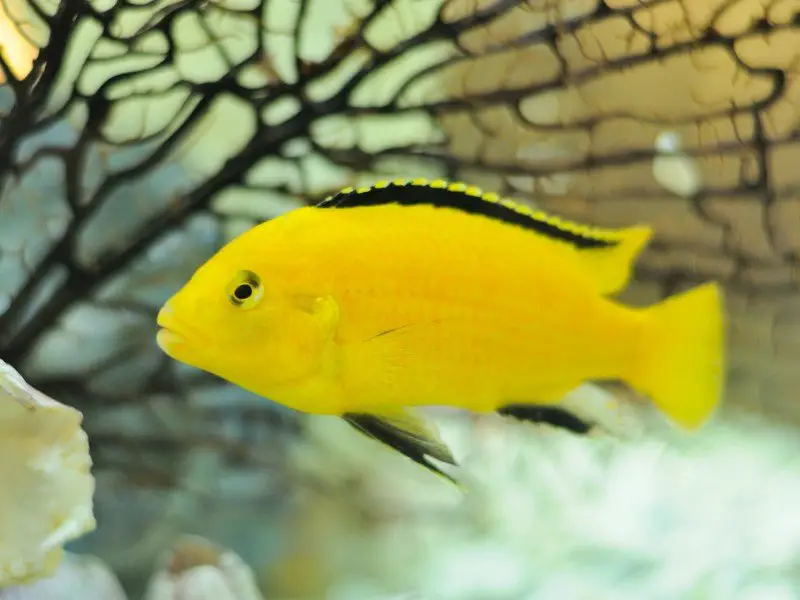
You should feed yellow lab cichlids tropical fish food, bloodworms, and frozen food. Yellow cichlids need a balanced diet consisting of protein and vegetation. This species eats snails, small fish, bugs, bug larvae, and algae in the wild.
Feed yellow lab cichlids three times daily. You should feed them enough food to eat in a minute to avoid overeating. Overeating will cause sickness and make the fish lethargic.
Live and frozen foods are ideal snacks for yellow lab cichlids. Tropical fish food and fish food flakes are good meal options.
Breeding
Yellow lab cichlids are easy to breed in captivity. Cichlids are sexually mature by six months old when the fish are 1.5 inches long. Females incubate fertilized eggs in their mouths for up to three weeks until the fry hatch.
Follow these steps to successfully breed yellow lab cichlids:
- Place the fish into a breeding tank that is at least four feet long and decorated with live plants and decorations.
- Make sure the water temperature is roughly 80°F and that the pH level is 8.0.
- Feed the fish three to four times per day. Be careful not to overfeed the fish.
- Yellow lab cichlids that are ready to breed will dig at the substrate. Females will appear round and plump.
- The breeding pair will swim in circles around one another near the nest.
- Females collect fertilized eggs in their mouths.
Females will look after the eggs until they hatch. Eggs take up to three weeks to hatch. Feed fry groundfish flakes and fry food until they are big enough to eat adult food.
Should You Get a Yellow Lab Cichlid for Your Aquarium?
Yellow lab cichlids are peaceful freshwater fish with mildly aggressive and territorial tendencies. These fish are better suited for experienced aquarists. However, confident amateurs can care for yellow lab cichlids with the right tank setup.
The yellow lab cichlid is easy to breed and will provide you with years of entertainment. Yellow lab cichlids are colorful fish that make interesting additions to freshwater community tanks.

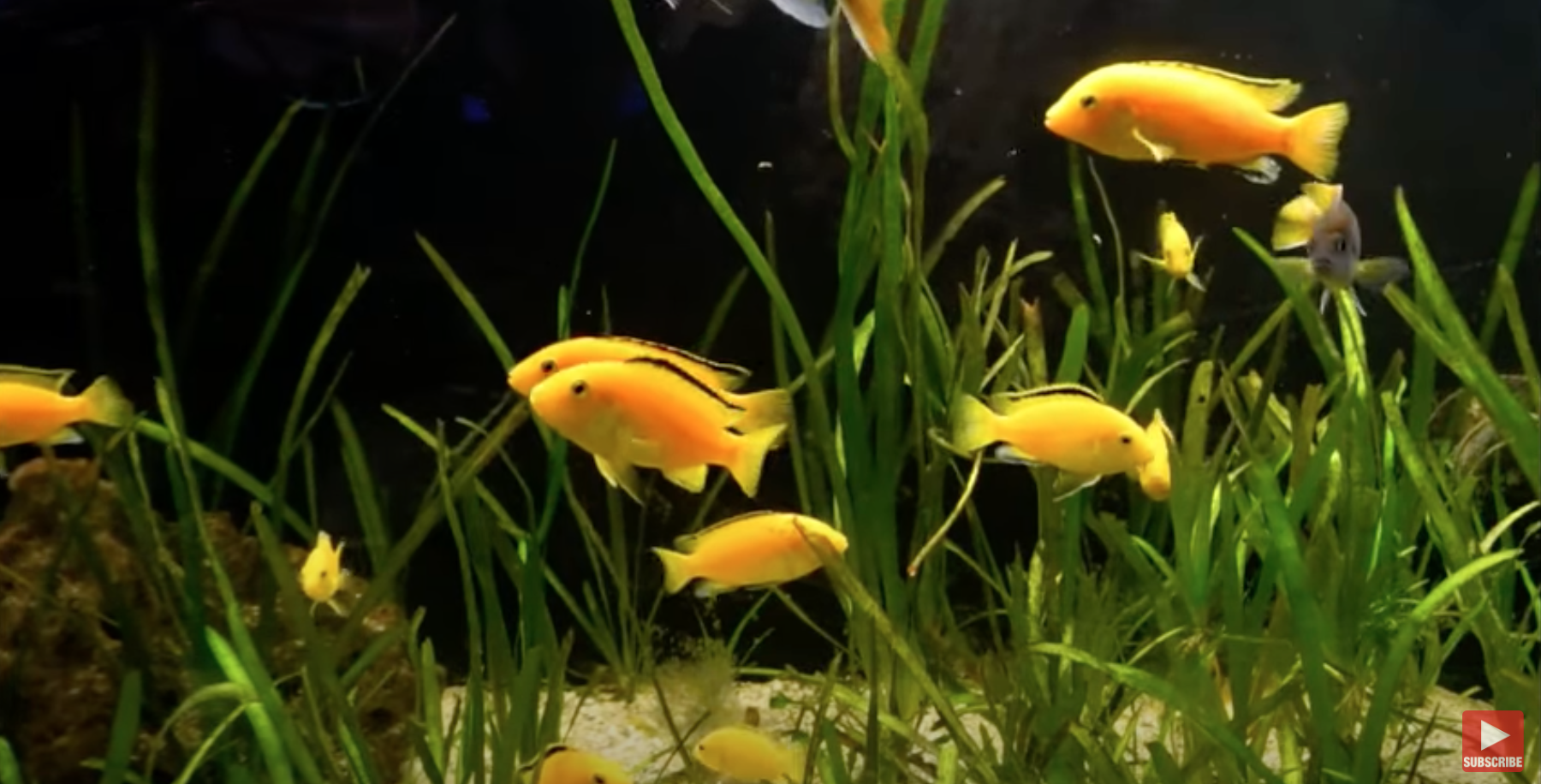
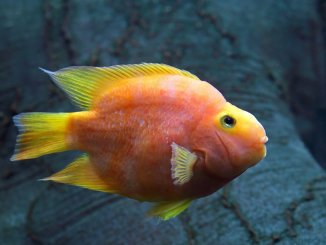
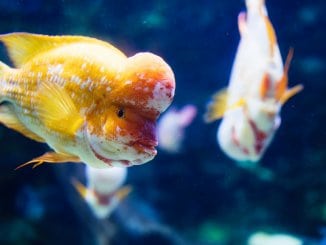
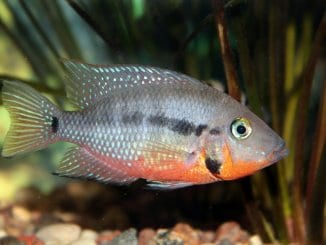
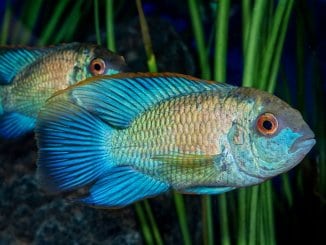
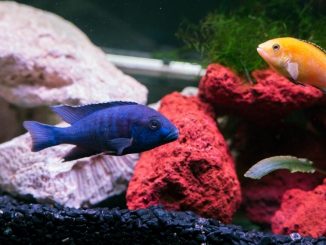
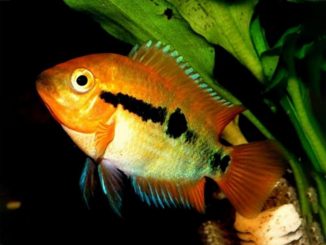
Be the first to comment